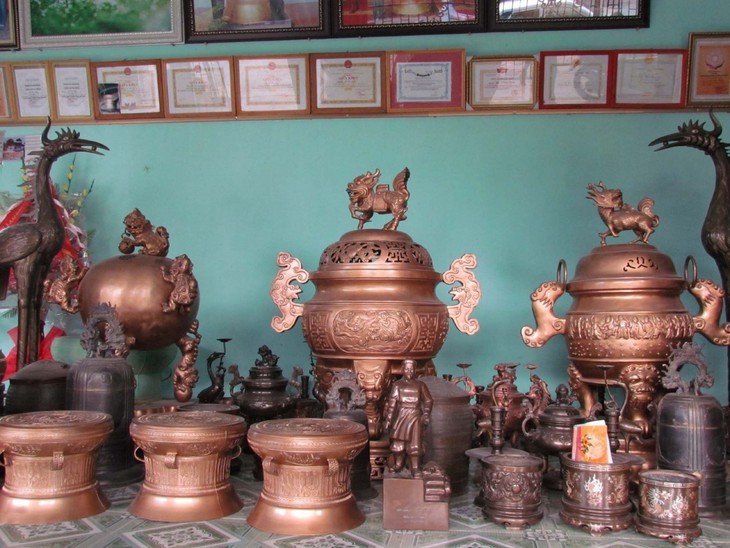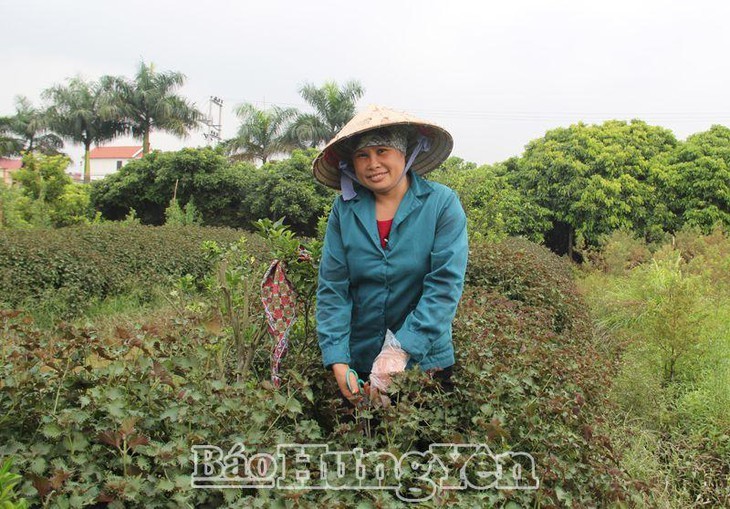(VOVWORLD) - Van Lam, a key industrial district of Hung Yen province, has preserved the ancient beauty of the Vietnamese village, with banyan trees, a river wharf, a communal yard, and traditional crafts and customs. Join us on a tour of Van Lam to see how craft villages have been changing and contributing to local economic development.
 Bronze products made in Long Thuong village (Photo: VOV) Bronze products made in Long Thuong village (Photo: VOV)
|
Located in the middle of the Red River Delta, Van Lam district has a long history and is a key economic area of Hung Yen province.
Over the years, traditional crafts in Van Lam district have played an important role in restructuring the agricultural and rural economy, generating jobs, and increasing incomes for local people.
Long Thuong, a bronze-casting village, is famous in Van Lam. The village has 200 households engaged in the trade, employing 1,000 people. On average, it supplies the market with about 31,000 items per year, earning approximately 4 million USD.
Bronze casting has truly improved material and spiritual life for the locals in Loc Thuong village, and Dai Dong commune in particular.
Thanks to the province’s industrial promotion program, bronze casting workshops in Long Thuong have updated their technology, trained their employees to create high-end products, developed brands, and increased their competitiveness.
Long Thuong bronze products have been recognized as one Van Lam district’s 14 signature products under the “One Commune One Product” program. This recognition has encouraged locals to make a large investment in production to strengthen their businesses.
The capital provided by the industrial promotion program has helped traditional craft villages improve product quality and value, expand their markets, and preserve their culture.
In addition to bronze casting, Van Lam has long been famous for growing medicinal plants mainly in Nghia Trai and Tang Bao hamlet in Tan Quang commune.
With their advantages over soil and the local people having gained much experience and knowledge, in recent years, the area has expanded their devotion to medicinal plant cultivation. They are focusing on the ones with high economic value including patchouli, Vietnamese balm, perilla, and plantain.
Each year Tan Quang supplies the market with as much as 8,000 tons of herbs of various kinds.
In particular, chrysanthemum turns out high economic value. Every year in November and December, roads leading to the village are surrounded with green chrysanthemum gardens. Cuc chi (chrysanthemum indicum) flowers blooming brilliantly have created romantic and beautiful scenery, attracting plenty of young people snapping shots. Chrysanthemum indicum is the raw material for making herbal tea, a specialty of most medicinal herb makers in Nghia Trai.
Vietnamese balm, another specialty of Nghia Trai, is grown for seeds to make medicine and beverages. The plant is intercropped with other medicinal herbs including sarsaparilla, ligusticum striatum, and rheumatism in two crops a year. The longer it is cultivated, the higher quality it turns out. Local terrain and climate have made herbal plants develop well and become resistant to pestilent insects, helping Nghia Trai farmers use pesticides less, if at all. Medicinal plants are picked, cleaned, chopped, naturally dried or dried in an oven.
 Farmers in Tan Quang commune harvest perilla (Photo: baohungyen.vn) Farmers in Tan Quang commune harvest perilla (Photo: baohungyen.vn)
|
Many villagers have been engaged in the profession to prescribe traditional medicine for treatment, which has been passed down for generations to generations.
Van Lam has 130 ha devoted to growing medicinal plants. Over the years, the district has financed the development of medicinal plant production communes with Tan Quang, Viet Hung (growing Ming aralia), and Minh Hai (growing black peanuts) having the greatest initial success. Van Lam district plans to expand the areas devoted to medicinal plants and develop new models linking production and sales.
As Van Lam-based companies like the Traphaco Hung Yen Company and the Hoa Thien Phu Production and Service Cooperative, buy all the output of local farmers, the output is stable.
According to the Department of Agriculture and Rural Development, Hung Yen has 850 ha of herbal plants.
The plants are so profitable that many households plan to expand their production to boost their income and make medicinal plants their family’s main crop.
Developing a traditional craft village economy based on highly profitable products is a new direction for Van Lam district.
Craft villages across Hung Yen province are changing rapidly to keep up with Vietnam’s international integration and contribute more to the local economy.